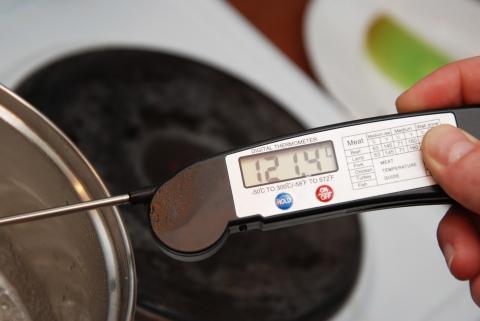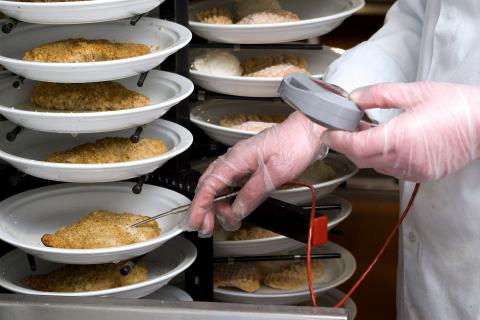
Results of Inspections
Inspection Results Are Available For You to View
Restaurant inspections are provided here so that you can be better informed about the inspection process. During inspections, food inspectors focus on assessing the degree of active managerial control that establishments have over contributing factors that directly relate to food safety concerns within retail food establishments. The five food safety concern categories are referred to as foodborne illness risk factors and they include:
- Food from Unsafe Sources
- Inadequate Cooking
- Improper Holding Temperatures
- Contaminated Equipment
- Poor Personal Hygiene
We hope that these inspection reports provide insight on conditions observed during the last inspection. As you review inspections, please keep in mind that the inspection reports capture only a "snapshot in time" and reflect conditions that were observed on that particular day. On any given day, establishment conditions can go from good to bad or bad to good within a matter of a few minutes.
Inspections are performed periodically to assess how well food establishments have incorporated specific actions or procedures into their operation to gain control over foodborne illness risk factors. When establishments take a preventive rather than reactive approach to food safety through a continuous system of monitoring and verification they are more likely to achieve active managerial control which ultimately minimizes, eliminates, or reduces the possibility of foodborne illness risk factors occurring in their establishment.
During inspection, inspectors verify that the establishment makes immediate correction during inspection (CDI) so that consumers do not become sick or injured. Observations made on the day of the inspection, as well as information gained about the behaviors, activities, and procedures that occur at other times, allow inspectors to assess the strengths and weaknesses of the food safety management system that is in place. Inspectors also inform establishments of inspectional findings both during, and at the conclusion of the inspection. They also discuss strategies for achieving compliance in the future. Follow-up activities occur within two weeks if the previous inspection failed.
Inspection violations are placed into three categories: (1) Priority items are proven measures that are directly linked to the elimination, prevention or reduction of hazards associated with foodborne illness; (2) Priority Foundation items that incorporate specific actions, equipment or procedures to control foodborne illness risk factors and (3) Core violations that relate to general sanitation & maintenance, equipment design & maintenance, and physical facilities & structures.
Food Inspection Search Options
In order to use the Quick search tool shown below, type a Keyword then use the Filter to select from either Establishment Name, Address, or Zip Code before clicking Search.
There is an option to also use the Advanced search tool which provides additional filter options including precision, date range, establishment class, and (number of) results. The establishment class is the type of the establishment such as Bar, E3-School, Mobile Food Prep, etc.
To find additional contact information on an establishment please use other avenues.
Food establishment inspections are based on the establishment priority, previous inspection results, and complaints that are received from consumers.
Routine
Most inspections performed are unannounced routine inspections that occur at a frequency based on the establishment priority rating.
- High priority establishments receive a minimum of three routine inspections per year,
- Medium priority establishments receive a minimum of two inspections per year,
- Low priority inspections receive a minimum of one inspection per year.
Follow-up (Compliance)
When an establishment has a non-compliant inspection, depending on the severity of violations observed, a documented compliance inspection takes place within two weeks following the initial failing inspection.
New Establishment
This inspection activity designation is selected when a food establishment meets code requirements and license permits are issued so that they can open for business.
Complaint
When THD receives complaints, the inspection that occurs is unannounced and typically focuses on the issue complained about. Following the onsite complaint investigation, the complaint and observed issues are discussed with management.
Other
These inspections are usually conducted during the construction phase of food establishments or for other documented onsite investigations to ensure that previous issues are addressed. For example, THD inspectors schedule courtesy inspections with food establishment management after a failed inspection to work with them on long term solutions for food safety issues at their establishments.
- Priority: food code requirements that are directly linked to the elimination, prevention or reduction of hazards associated with foodborne illness or injury. There are no other food safety provisions that more directly control hazards. Priority items include quantifiable measures that demonstrate control of hazards such as cooking, reheating, cooling, or handwashing.
- Priority Foundations: food code requirements that require that specific actions, equipment, or procedures by food industry management are taken to achieve control of risk factors that cause foodborne illness or injury such as personnel training, infrastructure, or necessary equipment, HACCP plans, documentation or record keeping, and labeling.
- Core: food code requirements that are not designated as a priority item or priority foundation item. Core requirements are usually related to general sanitation, operational controls, sanitation standard operating procedures (SSOPs), facilities or structures, equipment design, or general maintenance.
The inspection results provided on our website are uploaded after internal review and are organized by date for your review. Presenting establishment inspection report history better reflects the overall status of the facility. Inspections are provided in chronological order with the most recent inspection first. If enforcement actions are taken at the time of inspection such as warnings or tickets, that information is also indicated on the inspection report.



